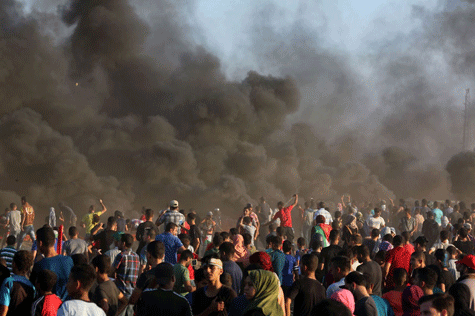by ANDREW SILOW-CARROLL
(JTA) — The New York Times devoted much of its front page and three inside pages Sunday to a reconstruction of the circumstances surrounding the June death of a Palestinian medic during riots at the Israeli fence with Gaza.

The newspaper concludes that the shooting of 20-year-old Rouzan al-Najjar by an Israeli soldier “appears to have been reckless at best, and possibly a war crime, for which no one has yet been punished.”
The investigation is already making waves — among those who objected to Israel’s use of deadly force to quell the rioting at the border fence and those who charge The Times with a pattern of bias directed at Israel.
How was the piece reported?
David M. Halbfinger, the paper’s Jerusalem bureau chief, is given the byline on a story reported by him and six colleagues. The Times says it analyzed more than 1,000 photos and videos taken by photographers, protesters, bystanders and medics during the June 1 riot, and interviewed more than 30 witnesses. The research agency Forensic Architecture, which has also worked with the Israeli human rights group B’Tselem to investigate allegations of Israeli military abuses, helped create a 3-D model of the scene. Interviewees included Gaza health officials and Israeli military officials.
Who is Rouzan al-Najjar?
The article describes the young medic as a “charismatic and committed” Gaza resident who was “largely self-taught” in first aid and “lied about her lack of education. She was a feminist, by Gaza standards, shattering traditional gender rules, but also a daughter who doted on her father, was particular about her appearance and was slowly assembling a trousseau.”
The Times also says that she frequently joked with her friends about becoming a martyr, and kept returning to the scene of the deadly confrontations over the warnings of friends and family.
How did she die?
The fatal shot came at 6:31 p.m. from the Israeli side of the fence, 120 yards away, following a day of rioting that seemed to be winding down. Najjar was standing amid a group of protesters and medics who were treating others for the effects of tear gas when she was shot in the chest and died within minutes. The Times says its reconstruction confirmed that a single bullet hit the ground, fragmented, and managed to strike three medics, including Najjar.
Why do they say it might be a war crime?
Israel acknowledges that it uses live fire at the Gaza fence confrontations, especially for those hurling projectiles like rocks or Molotov cocktails, or attempting to breach the fence, but aims at the ground or protesters’ lower extremities to lower the risk of deadly casualties. It also says it treats unarmed and armed Hamas operatives as a violent threat.
The army told The Times that it was targeting a man in a yellow shirt who was throwing stones and pulling at the fence, but The Times claims the only man fitting that description was about 120 yards from the fence and posed no threat. The newspaper quotes “former Israeli and American snipers” saying it would be reckless and possibly a war crime if anyone who was not a legitimate target could be put at risk.
“The laws of war would not want any military personnel to deliberately fire in the direction of the medics,” explains Ryan Goodman, a law professor at New York University who was a special counsel to the Pentagon on war crimes. “I’m not saying it’s close to the line. I’m saying it crosses the line.”
How has Israel responded?
In addition to saying that it was targeting the man in the yellow shirt, the army insists that its soldiers were following the rules of engagement that snipers may shoot only at people posing a violent threat. Lt. Col. Jonathan Conricus said that Najjar’s killing was unintended.
“She was not the target,” Conricus says. “None of the medical personnel are ever a target.”
The article reports that 185 Palestinians have died in rioting at the border fence that began in late March. It cites a senior Israeli commander who told The Times in August that 60 to 70 other Gaza protesters had been killed unintentionally, around half the total killed at that point.
In addition, “Israeli military lawyers conceded there had been some misconduct but said that no soldiers were suspected of intentionally killing anyone they knew they shouldn’t have.”
What are the critics saying?
Ira Stoll, who runs a website that critiques The Times, says the article is one-sided in its description of the Israeli-Gazan conflict, using “language to exculpate Palestinian Arab terrorism” — for example, by describing rockets from Gaza in the passive voice without noting that they are aimed at Israeli civilians by Hamas operatives. He asks why the paper devoted so many resources to the death of the Palestinian medic but has so far ignored the murder of Ari Fuld, an Israeli American who was killed in September by a Palestinian terrorist in a stabbing attack near his hometown of Efrat.
“The New York Times’ investigation,’ for all its dignified trappings, is just the same old Israel-bashing you can get for free on any extreme right or extreme left Internet site or social media feed,” Stoll writes in The Algemeiner.
Seth Mandel, executive editor of the Washington Examiner, says the article was “sickening” in the way it downplayed the violence of the Palestinian rioters.
What do you call an attempt to storm a border fence with the stated goal to kill the Jewish civilians on the other side as part of a plan to destroy the Jewish state?
If you’re the NY Times, you call it “protests against Israel’s blockade of the Gaza Strip”.
Sickening, NYT. pic.twitter.com/bVp6xq0JGZ
— Seth Mandel (@SethAMandel) December 30, 2018
By contrast, Oded Shalom, a columnist for the Israeli news site Ynet, admires the legwork that The Times put into the article.
“As an Israeli journalist I can only envy the thorough work of Halbfinger and his colleagues,” he writes. “Having the time and resources for such investigative work should not be taken for granted. While the Gaza Strip remains closed to Israeli journalists — on the orders of the Israeli security forces — the foreign media is free to enter. Us Israeli journalists have to rely on announcements from the IDF Spokesperson, and have no way of properly cross-referencing information. That isn’t journalism at its best, even though some of us have sources across the border and can ask for comments, or verify some details.”



















